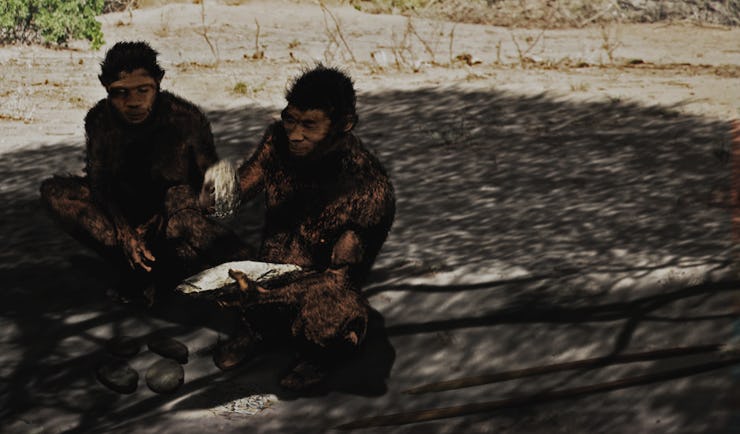First Humans Stuck to Vegan Diet as Grasses Spread in Africa
The climate changed, our brains changed, our taste for forest treats remained.

In a major philosophical victory for vegans everywhere, new evidence suggests that the earliest humans evolved from ape-like ancestors without first shifting to a meat-based diet. Research published Monday in Nature Ecology & Evolution suggests that the first members of the Homo genus ate mostly vegetation from trees and shrubs, just like their ancestors Australopithecus.
The story normally goes that between 3.2 and 2.8 million years ago, the climate in parts of Africa was becoming cooler and drier, and grasslands were gaining ground where forests had once stood. The first humans seized the opportunity to walk out from the woods and began hunting large grazing mammals. This abundant source of easy calories allowed our brains to grow big and ultimately made us who we are today. But a new study could rewrite the narrative.
“The most surprising part of the results was that we did not document a shift in the diet of early Homo considering the preponderance of evidence for open and grassy environments,” writes lead author Joshua Robinson, a postdoctoral researcher with Arizona State University, in an email to Inverse.
This research sprang from the 2013 discovery of an early Homo jawbone from Ledi-Geraru in the lower Awash Valley of Ethiopia. It dates to 2.8 million years ago — 400,000 years older than the oldest previously known Homo specimen. The location of the find is significant — just 30 kilometers from where the famous Australopithecus afarensis Lucy fell to her death from a tree 3.2 million years ago.
The 'Australopithecus afarensis' were the precursors to the very first in the genus 'Homo'.
Somewhere between these two dates the major morphological shifts that mark the transition between Australopithecus and Homo occurred. And, as Robinson’s research team confirmed, the climate was shifting, too. The scientists analyzed animal fossils at the same site to determine that indeed mostly grass grazers were present by 2.8 million years ago. Some animals had even shifted their diets to match the environment. Notably, the giraffe-like Sivatherium switched from eating mostly tree leaves to mostly grasses at that time. It is therefore even stranger that early Homo appear to have stuck to a woodland diet.
The researchers looked at stable carbon isotopes in the teeth to figure out what the animals, including Australopithecus and Homo, were munching on. This gives a pretty good idea but not an exact picture. The analysis might not be precise enough to show subtle dietary shifts, says Robinson. And yet it appears that both Lucy and the earliest Homo ate meat only rarely, and that treed regions must have persisted even as grasslands became the norm.
Certainly at later points in human evolution meat eating became a bigger part of life, and this very well may have contributed significantly to the animals that we have become. But as early Homo 2.8 million years ago and vegans today show, you don’t need to ingest animal protein to be smart.
Abstract
It has long been hypothesized that the transition from Australopithecus to Homo in eastern Africa was linked to the spread of open and arid environments near the Plio−Pleistocene boundary, but data for the latest Pliocene are scarce. Here we present new stable carbon isotope data from the late Pliocene mammalian fauna from Ledi-Geraru, in the lower Awash Valley (LAV), Ethiopia, and mammalian community analyses from the LAV and Turkana Basin. These data, combined with pedogenic carbonate stable isotopes, indicate that the two regions were largely similar through the Plio−Pleistocene, but that important environmental differences existed during the emergence of Homo around 2.8 million years ago. The mid-Pliocene to late Pliocene interval in the LAV was characterized by increasingly C4-dominated, arid and seasonal environments. The early Homo mandible LD 350-1 has a carbon isotope value similar to that of earlier Australopithecus from the LAV, possibly indicating that the emergence of Homo from Australopithecus did not involve a dietary shift. Late Pliocene LAV environments contrast with contemporaneous environments in the Turkana Basin, which were more woody and mesic. These findings have important implications for the environmental conditions surrounding the emergence of Homo, as well as recent hypotheses regarding Plio−Pleistocene environmental change in eastern Africa.